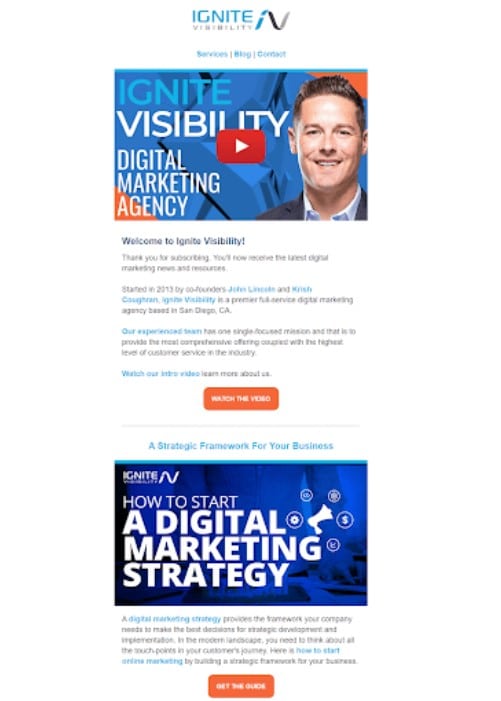An efficient client onboarding process sets the foundation for a strong, long-term relationship. Without a clear structure, miscommunication and delays can slow things down, leading to frustration on both sides. That’s where a client onboarding checklist comes in.
In this guide, we’ll walk you through a step-by-step client onboarding checklist designed to streamline your process, enhance client satisfaction, and set every new project up for success.
Client onboarding checklists
A client onboarding checklist is your go-to guide for bringing new clients into your agency efficiently. It’s a structured list of steps that ensures you don’t miss any critical details when starting a new client relationship.
Think of it as a framework that helps you:
- Set clear expectations from day one
- Gather all necessary information and assets
- Establish communication channels
- Ensure an easy shift from sales to service delivery
Without a strong onboarding process, you risk confusion, missed deadlines, and a frustrated client. But with a well-organized checklist, you create a professional, streamlined experience that builds trust and leads to long-term success.
In short, a client onboarding checklist helps you stay organized, satisfy clients, and build a strong start for a productive partnership.
Importance of a structured client onboarding process
A structured client onboarding process isn’t just a formality—it’s the backbone of a successful agency-client relationship. Here’s why it matters:

1/ Builds trust and confidence
First impressions matter. When a client sees a clear and professional onboarding process, it immediately reassures them that they’ve made the right choice. A well-structured approach shows that your agency is organized, experienced, and committed to delivering results. This trust is crucial for long-term collaboration.
2/ Prevents miscommunication
Misaligned expectations can lead to frustration, missed deadlines, and unnecessary back-and-forth discussions. Without a structured onboarding process, clients might assume certain services are included, while your team might have a different understanding of the project scope.
This disconnect can cause delays and even damage client relationships. By laying everything out clearly during onboarding, goals, deliverables, timelines, and responsibilities, you eliminate ambiguity. Clients know exactly what to expect, and your team understands their tasks from the start.
3/ Saves time and effort
Without a proper onboarding system, your team might waste valuable time chasing clients for information or re-explaining things. By gathering everything you need at the start, you ensure a smoother workflow, allowing your team to focus on execution instead of admin work.
4/ Enhances client satisfaction
First impressions set the tone for the entire client relationship. When clients feel guided, supported, and well-informed from the start, they develop confidence in your agency’s ability to deliver results.
A structured onboarding process reassures them that they won’t have to chase updates or worry about miscommunication, it shows that you have a clear plan in place.
Beyond just making a good impression, an organized onboarding experience also makes clients more engaged and cooperative.
5/ Improves team collaboration
Onboarding isn’t just about the client—it’s about internal efficiency, too. A clear process ensures that every team member knows their role, reducing the chances of missed deadlines or overlooked tasks. When your team works in sync, projects run more smoothly.
The client onboarding checklist (step-by-step)
Step 1: Pre-Onboarding preparation
Before signing a client, ensure your agency is fully prepared.
1.1 Define your ideal client
Before onboarding a client, it’s essential to determine whether they’re the right fit for your agency.
Start by identifying your target audience and ideal client profile. Consider factors such as:
- Industry and business size, like finance, healthcare, and cryptocurrency.
- Budget and willingness to invest in your services
- Business goals and pain points
- Preferred communication and collaboration style
For instance, if your agency works with clients in the finance sector, you might help them navigate complex topics such as how to compare best-shared equity loans or optimize investment strategies. Understanding these specific needs allows you to tailor your services accordingly.
Once you have a clear profile, evaluate whether a prospective client’s needs align with your services. If their expectations exceed your capabilities or they require services outside your expertise, it may be best to refer them elsewhere rather than risk a strained working relationship
1.2 Set up onboarding documents & tools
A well-organized onboarding process starts with the right documents and tools. If your agency works with industries like healthcare or SaaS, customized templates can help streamline onboarding.
Some companies go a step further by integrating a smart template for Jira or using background check software as part of their workflow, especially if recruitment, staffing, or HR support is part of their services. These tools help automate candidate screening, improve hiring accuracy, and ensure compliance throughout the process.
Here’s what you need to prepare:
Create templates for contracts, proposals, and welcome kits
Instead of starting from scratch with every new client, set up standardized templates for key documents:
- Contracts & agreements – Clearly outline project scope, timelines, deliverables, payment terms, and any other legal considerations to avoid misunderstandings later.
- Proposals – If you haven’t already finalized details during the sales process, having a proposal template helps formalize what you’ll be delivering.
- Welcome kits – A branded welcome package can include an introduction to your agency, key contacts, FAQs, and an outline of what to expect moving forward.
Set up a project management tool
Use a project management tool like Teamwork, Asana, ClickUp, Prodacker, or Quickbase to keep everything organized.
Pairing this with a software management tool helps agencies efficiently manage client workflows, track tasks, and oversee software-related assets.
These platforms help you:
- Track tasks, deadlines, and deliverables in a clear, visual format
- Assign responsibilities to team members and keep workflows streamlined
- Provide clients with progress updates and a transparent view of the project timeline
1.3 Assign internal responsibilities
Clear role assignments prevent confusion, ensure accountability, and keep projects running smoothly.
Designate an account manager or primary point of contact
Every client should have a go-to person within your agency. This could be:
- An account manager who oversees communication, ensures the client’s needs are met, and handles any concerns.
- A project manager who keeps track of deliverables, deadlines, and team coordination.
Having a dedicated point of contact streamlines communication, prevents delays, and reassures the client that they always have someone to reach out to for updates.
Ensure your team understands the project scope and client expectations
Before diving into execution, every team member involved in the project should have a clear understanding of:
- The client’s goals and priorities – What success looks like for them.
- Project scope and deliverables – What’s included (and what’s not).
- Timelines and key deadlines – When deliverables are expected.
- Client preferences and communication style – How often are updates needed and through which channels?
Step 2: Initial client contact
Once the client has signed on, the way you communicate in the first few days sets the tone for your working relationship. A professional and welcoming onboarding experience reassures clients that they’ve made the right choice and helps establish trust.
2.1 Send a welcome email

(Source)
Your first step is to send a warm and professional welcome email. This email should:
- Thank the client for choosing your agency and expressing excitement about working together.
- Outline the next steps so they know what to expect in the coming days. This could include scheduling an initial call, providing access to necessary tools, or filling out an onboarding questionnaire.
Before sending the welcome email, use an email verification tool to confirm the accuracy of the client’s email address. This helps prevent bounce-backs and ensures smooth communication from the beginning.
- Share essential documents like contracts, project timelines, or a welcome kit.
- Introduce the team members they’ll be working with, including their roles and how they will contribute to the project.
A well-structured welcome email reassures the client that your agency is organized and ready to get started.
I asked Mushfiq Sarker, CEO of LaGrande Marketing – a law firm marketing agency known for its high-retention client base – what most agencies overlook during onboarding.
“One of the biggest mistakes agencies make is assuming the client already knows what to expect. Clear communication during onboarding isn’t just helpful. It’s essential. Early in our journey at LaGrande Marketing, we didn’t clearly define deliverables upfront, leading to clients requesting more than what was originally scoped. That kind of confusion can quickly erode trust. We learned that setting expectations early protects both the client relationship and your team.”
This early alignment prevents confusion and sets the tone for a professional, transparent relationship.
That’s why your welcome email isn’t just a formality – it’s your first opportunity to show structure and intent.
2.2 Schedule a first call
A first call is the first real interaction between your team and the client, and it’s crucial for aligning expectations. Use this meeting to:
- Discuss goals, deliverables, and timelines – Ensure everyone is on the same page regarding what achieving the goal looks like and what the key milestones are.
- Address any client questions or concerns – Allow them to clarify anything that might be unclear.
- Set expectations on communication – Define the preferred communication channels (email, Slack, Zoom, etc.) and how often they can expect updates.
This call helps avoid future miscommunication and ensures a better working relationship. You can also use creative first-call solutions, such as a collective webinar thanks to software like Contrast, or send pre-recorded videos for product demos or pre-audits. This first touchpoint is the opportunity to stand out from the competition and leave a great first impression.
2.3 Gather essential information
You need the right information and access to critical assets to begin work efficiently. Request:
- Logins and access to platforms like the client’s website, analytics tools (Google Analytics, SEMrush), social media accounts, or advertising dashboards.
- Branding guidelines such as logos, color schemes, fonts, and tone of voice are documented.
- Previous marketing materials, like past campaigns, competitor research, or any data that could help your team create a more informed strategy.
- If the client operates an e-commerce store, gather insights into their current sales funnel and upselling strategies. This is a great opportunity to suggest solutions like a Shopify upsell app to help increase revenue and improve customer experience.
Step 3: Setting up for success
Once the onboarding basics are covered, it’s time to ensure your team has everything needed to execute the project efficiently. This step is all about organization, communication, and workflow management, setting the foundation for a successful engagement.
3.1 Define project scope & deliverables
Before work begins, it’s crucial to have a clear and documented plan that outlines exactly what’s expected from both your team and the client.
- Break down tasks and milestones into a clear timeline – Outline the key phases of the project, from research and strategy development to execution and final review.
- Confirm deliverables, deadlines, and approval processes – Specify what your agency will deliver, when each deliverable is due, and how approvals will be handled.
- Document everything to avoid misunderstandings later – A detailed statement of work helps and ensures that everyone is aligned on what’s included (and what’s not).
By having this in writing, you reduce the risk of miscommunication and keep the project on track.
3.2 Establish communication & reporting
Clear and consistent communication is key to maintaining a productive relationship. Set up standardized communication and reporting practices so everyone knows what to expect.
- Set up a shared communication platform – Whether it’s Slack, email, or a project dashboard, make sure there’s a dedicated space for discussions, updates, and questions.
- Define reporting frequency – Will you provide progress reports weekly, bi-weekly, or monthly? Make sure the client knows when to expect updates.
- Explain how progress updates and feedback loops will work – Define how you will track progress, request feedback, and address client concerns. For example, will you use status updates in a project management tool, or will there be formal review meetings?
Setting these expectations upfront prevents unnecessary back-and-forth and keeps both parties aligned throughout the project.
3.3 Create a workflow & timeline
A well-structured workflow ensures that tasks are completed efficiently and on time.
- Assign tasks to team members – Clearly define who is responsible for what, so there’s no confusion about ownership.
- Use a project management tool to track progress – Platforms like ClickUp and Apollo discount for cost-effective access to their better features, helping you organize tasks, set deadlines, and monitor real-time progress.

(Source)
- Schedule check-in meetings – Regular internal team check-ins help review progress, address concerns, and adjust workflows as needed. You can also schedule client check-ins to discuss milestones and gather feedback.
Step 4: Delivering the first results
This step is critical because it’s your agency’s first opportunity to prove value, build trust, and strengthen the client relationship.
4.1 Deliver initial work for feedback
Your first round of work should showcase your expertise and attention to detail while aligning with the expectations set during onboarding.
- Submit the first set of work on time – Meeting deadlines early in the project reassures clients that they can trust you to stay on schedule. It also establishes confidence in your agency’s reliability.
- Gather client feedback and improve based on their input – Encourage the client to share specific feedback so you can make necessary adjustments. You can do this through:
- A structured feedback form
- An SMS Survey tool
- A scheduled review call
- Comments directly in a shared document or project tool
4.2 Address client concerns proactively
Even with a well-planned onboarding process, clients may have concerns or additional requests once they see the initial work. How you handle these concerns will significantly impact the client’s confidence in your agency.
- Stay responsive to client queries – Quick and thoughtful responses show that you take their input seriously. Delayed or generic replies can lead to frustration and misalignment.
- Make revisions as necessary to align with client expectations – If feedback requires adjustments, be open to revisions while ensuring they stay within the agreed project scope. If additional requests arise, clarify how they will be handled (e.g., additional costs, extended timelines).
Step 5: Ongoing client relationship & optimization
Onboarding doesn’t end once the first work is sent. To build a long-term partnership, your agency needs to maintain communication, continuously improve processes, and identify growth opportunities.
5.1 Regular check-ins & progress updates
Consistent communication is key to ensuring clients feel informed and confident in your work.
- Maintain consistent communication and provide reports – Set a regular schedule for updates (weekly, bi-weekly, or monthly) to share insights, progress, and performance metrics. Use easy-to-digest reports, dashboards, or summary emails to keep things clear.
- Keep clients engaged and informed about the impact of your work – Don’t just list what you’ve done—explain the results. Whether it’s increased engagement, higher conversions, or improved brand visibility, show them the value your agency brings.
By staying proactive with updates, you avoid clients feeling left in the dark and reinforce your agency’s role as a strategic partner.
5.2 Collect feedback & improve the process
Gathering feedback isn’t just about client satisfaction—it’s about continual improvement for your agency.
- Ask for client feedback on the onboarding experience – Were the processes clear? Was anything unclear or frustrating? This insight helps you improve your approach for future clients.

(Source)
- Use insights to enhance your onboarding process – If multiple clients mention the same pain points or areas of confusion, make necessary adjustments. This could include improving documentation, streamlining approval steps, or enhancing communication touchpoints.
A feedback-driven approach ensures that your agency constantly grows and delivers an even better experience to future clients.
5.3 Set the stage for long-term success
Your best clients aren’t just one-time projects, they’re long-term partners. Proactively building the base for future collaboration benefits both your agency and the client.
- Discuss potential future opportunities and expansion of services – Once the client sees tangible results, introduce additional services that could further benefit their business. This could be upselling ongoing support, expanding marketing efforts, or offering software development services to enhance their digital infrastructure. If your client is looking to scale their digital presence, they may also want to hire dedicated mobile app developers to create a seamless user experience and drive engagement.
- Showcase the value your agency provides – Continuously remind clients of the results and progress achieved. Case studies, performance reports, and success stories help demonstrate why continuing to work with your agency is a smart investment.
Conclusion
A well-structured client onboarding process isn’t just a formality—it’s the key to building trust, avoiding miscommunication, and setting every project up for success. By following a clear checklist, your agency can stay organized, deliver a better experience, and strengthen client relationships from day one.
Investing in a strong onboarding framework not only improves client satisfaction but also makes things easier for your team. The result? Better projects, happier clients, and long-term partnerships that help your agency grow.



